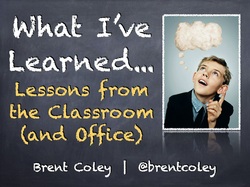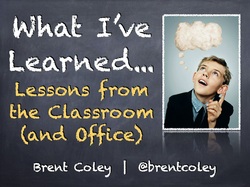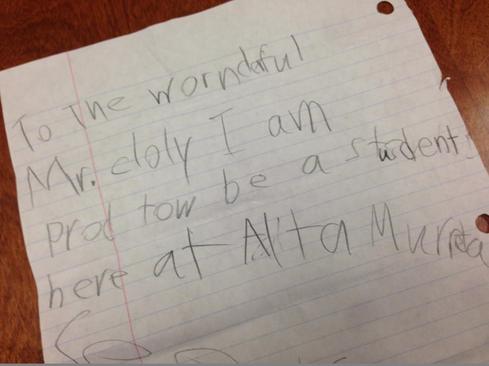 It’s been a little more than a year since I began serving as an elementary school principal, and as I reflect on my time spent in this position, one thing is clear -- this is a hard job. Don’t get me wrong. While difficult, it is also incredibly rewarding. My district’s superintendent, as we were walking through classrooms a few weeks ago, said something that is so true -- “Being an elementary school principal is as close to being a rock star as one gets.” As an assistant principal at a middle school, students ran away from me, the disciplinarian. As an elementary principal, students run to me. Being an elementary school principal definitely has it’s perks. Like hugs. If riches were measured in side hugs, I’d be very wealthy. Or dozens and dozens of finger waves each day. Those of you at the elementary school level know what I’m talking about. Or walking across campus and hearing your name spoken in unison by a group of students headed to the library or lunch. “Mr. Coley! Mr. Coley! Hi, Mr. Coley!” Or greeting students and parents at the front gate each morning with a high five, seeing their smiling faces, eager to learn. Or sitting in a kindergarten classroom. If you’re ever having a bad day, go sit in a kindergarten classroom for a little while. It’ll make you smile. Trust me. Or riding tricycles with kindergarteners, as seen in the video below. But being a principal is hard too. People often ask me, “What’s the hardest part?” Is it the long hours? No. Is it the stress? Definitely a stress-filled position, but no. Is it having to handle student discipline? No. Not fun, but not the hardest part. Is it speaking with upset parents? No. Again, definitely not fun, but not the hardest part. For me, the hardest part of being a principal is...wait for it... Feeling powerless. Wanting to help but not being able to do so. I moved into administration because I had a desire to support teachers, which in turn helps students and their parents. By providing support and encouragement at this level, I have the potential to affect change on a larger scale than I could in a single classroom. But what happens when I'm not able to help? What happens when the desire is there, but what is required is beyond my reach? Like when teachers come to me requesting additional staffing, but such hiring decisions are out of my hands. Or when some of our classroom computers are eight years old, and a limited budget makes the replacement process a painfully slow one. Or when a teacher comes to me needing a new lamp for her LCD projector, but the lamps I've ordered over a month ago haven't yet arrived and there are none available to borrow. Or when parents come to me with legitimate safety concerns regarding our parking lot, yet those concerns stem from other parents not following the rules or being courteous. How do I mandate manners? Or when a teacher asks me to work with that hard-to-reach student, but none of the tricks in my bag are working. This is the hardest part of my job. Wanting to help but lacking the expertise or resources to do so. It’s frustrating. I sometimes wonder if I’m making a difference, if I’m being a good leader. Last week a student handed me this note at dismissal time. I must be doing something right.
9 Comments
 Yesterday I had the privilege of talking education with the amazing Bedley Brothers, Tim and Scott. Both men are amazing educators (County Teachers of the Year, Tim in 2013 and Scott in 2014), but more than that, they are incredible people and friends. If you're not yet aware of their YouTube educational talk show, it is definitely something you need to check out. Each week, Tim, Scott, and a guest talk about issues at the forefront of education. Their list of past guests includes Robert Marzano, Daniel Pink, Rick Morris, Angela Maiers, Catlin Tucker, Vicki Davis and Dave Burgess -- amazing leaders in the field of teaching and learning. Not sure how I made it on the guest list, but I was honored to be able to chat with Tim and Scott for a few minutes. For about 20 minutes, we talked about lessons learned from our students, Common Core, EdCamps, and water bottles. What? Water bottles? Yep, water bottles. You can watch our conversation below.  UPDATE: Two days after writing this blog post, it was announced that unfortunately, Bump would be shut down effective January 31, 2014. More information can be found at here. There are a ton of great productivity apps out there, and in this post I want to tell you about Bump, one of my favorites. Recently acquired by Google, it's free and is available for both iPhone and Android. There are two main things Bump can do for you. First, it enables you to instantly transfer items from your phone (your contact information, other contacts, pictures, videos, and documents) to a friend’s phone. Once the Bump app is installed on both phones, you and your friend simply open the app on each of your phones, select what you want to share with your friend’s phone, and gently “bump” the phones together (they don’t even have to touch – you just simulate a bumping motion near the other phone). That’s it! You both simply tap the “Connect” button that will appear on your phone’s screen, and your contact, picture, or file is instantly transferred to your friend’s phone (or vice versa). Oh, and it’s cross-platform, meaning it works iPhone to iPhone, Android to Android, iPhone to Android, and Android to iPhone. But it's the second feature of Bump that, in my opinion, makes this app an absolute must-have. In addition to sharing pictures with a friend's phone, you can also go to www.bu.mp and use your phone’s Bump app to transfer photos from your phone to your computer by simply bumping your phone on the space bar. No more having to email yourself photos from your phone in order to get them onto your computer! As a principal, I frequently use my phone to snap pictures of things around campus (e.g. a picture for the school website, great student artwork, a photo of an area on campus that needs repair), so using Bump in this way is a huge time saver when I need to get pictures from my phone to my computer. Watch the short video below to see how this feature works. If you're like me and use your phone to take pictures, I highly encourage you to check out Bump to make transferring those pictures to your computer a snap (a bump actually). Again, the app is free and available for both iPhone and Android. You can go to your phone’s app store to download the app or follow the links below:
iPhone – https://itunes.apple.com/app/bump/id305479724?mt=8 Android – https://play.google.com/store/apps/details?id=com.bumptech.bumpga  What's in a name? This is an expression we've all heard before, but what's the answer? Are names important? In this fourth video of my "What I've Learned" series, I share two of my experiences, one from a teacher's perspective and one from an administrator's point of view. Through these short stories, you'll see that a person's name isn't just important, it's powerful. If you haven't yet watched the first three videos in the series, you can do so by visiting the "What I've Learned" page. If you've already seen them, I welcome your feedback.  Here's the second story in my new series "What I've Learned...Lessons from the Classroom (and Office)." In this video, I share an experience from my very first year of teaching. While it was definitely not one of my prouder moments (as you'll see in the video), I learned an extremely valuable lesson about the kind of teacher I want to be. I hope you find my story to be helpful. If you haven't yet watched the first video in the series, you can do so by visiting the "What I've Learned..." page.  Those who know me personally know that I am a rule follower. Always have been, always will be. I think rules are important. Very important. Heck, when I text, I spell out all words, use proper punctuation, and capitalize appropriately. Why? Because those are the grammatical rules I was taught. I've been teased for my firm stance on adhering to rules. I've been told, "Lighten up, Brent. Don't be such a stickler." Here are my thoughts on the subject... Rules must be followed. When rules aren't enforced, they're not rules -- they're suggestions. If there is no consequence for not following a rule, then it's not a rule, because rules must be followed. Suggestions, on the other hand, are things we'd like people to do, not expect them to do. If you're not going to enforce a rule, get rid of it. A good rule is not arbitrary. Rather, it is put in place for a specific reason. From the time we were small children, we've had safety rules guiding our behavior. Don't run with scissors. Look both ways before crossing the street. Don't stick objects in an electrical outlet. All common rules there for our protection. Rules must be enforced by everyone in the organization. Inconsistent rule enforcement sends the wrong message. For example, fighting is prohibited in all schools, and I think it's pretty safe to say this is a rule that is consistently enforced. But what about, say, a "no gum" rule? If Teacher A enforces the school's "no gum" policy but Teacher B allows students to chew gum, what is the result? First, Teacher A is going to be perceived as the "bad guy" for not allowing students to chew gum. Second, students are sent the message that some rules are important (no fighting) and some aren't (no gum), and that they get to choose when and where they follow certain rules. Yes, there are major and minor categories of rules, but all rules should be important. That's why they're rules. Beware of the danger in suspending rules. When a rule is suspended ("Today you don't have to follow the rule"), it compromises the integrity of the rule. Again, it sends the message to students that on every other day, the rule is important, but not today. This is why I never used homework passes. I didn't want to send my students the message that homework is important and must be completed unless you have a pass. I felt that suspending the rule on homework would undermine the importance of the activity. The Three C's: Clarity, Consistency, and Consequences. Without these three things, students can't be sure of what to expect. Regardless of whether or not they'll admit it, students want (and need) rules. They want the structure and security rules provide. Clarity, consistency, and consequences are imperative, because without them, a fourth C is produced -- confusion. So now I must ask myself this question -- "Are all of my rules, both at school and at home, good rules?" Something to think about. Thanks for reading.  When I began my teaching career, people would often ask me, "So, do you want to be a principal some day?" My response was always along the lines of "No way! I have no desire to become an administrator." And I didn't. I became a teacher because I wanted to teach, not because it was a stepping stone to the administrative ranks. As an elementary school teacher, I was also asked during the early years of my career if I ever had plans to move up to middle school. Once again, I usually responded by saying that I was happy at the elementary level and had no plans to make the move to middle school. Yet here I am, an assistant principal at a middle school. Who would have thought? Never say never. I write this post after completing my first two days of the school year as a middle school administrator. How'd it go? It went well. My principal was ill and was forced to miss the final two days leading up to school starting as well as the first two days of school. That added to the stress of my new position, but my fellow assistant principal and I did our best to rally the troops, and all things considered, the first day went very smoothly. I even had the pleasure of speaking with a very, very upset parent. But I survived. The second day saw fundraiser assemblies, more breaks and lunches, and despite several dress code violations, the day once again ended well. One of my big goals this week was to make connections with students, to try and make the campus a place of safety. See, I had a miserable experience when I was in middle school. I was consistently picked on and rarely felt safe when I had to leave the classroom and walk around campus during breaks and lunches. So as I walked the campus these past two days, I saw myself in many of the 1,500 students. I saw myself in that scared boy or girl who just wants to feel comfortable at school, to make new friends, to fit in. Was I able to assuage the fear and uncertainty of every student on campus? Unfortunately, no. But it's my prayer that those I was able to meet and talk to felt a bit safer, a bit more comfortable, that their assistant principal is there to do everything he can to make sure they don't feel the way he felt when he was a 6th grader. I have a lot to learn, but I'm excited about this opportunity. God has placed me in this position for a reason, and I look forward to seeing what He has planned for me and Shivela Middle School. |
About BrentBrent has worked in the field of education as a teacher and administrator for 28 years. A former elementary school teacher and principal, he is currently Coordinator of Elementary Education in the Murrieta Valley Unified School District in Southern California. Read more about Brent here. Brent on X (Twitter)Archives
May 2024
Categories
All
|
Photos from somegeekintn, woodleywonderworks, Joybot, British Council Singapore, jseliger2, berkuspic, toddwendy, Alexandra E Rust, skippyjon, crdotx, tharrin, roybuloy, .FuturePresent., Just some dust, frankpierson, Jair Alcon Photography, Luigi Mengato, Muffet, stevendepolo, Pilar Soro, Sander van der Wel, jblyberg, jonathangarcia, DraXus, angeloangelo, Sthetic



 RSS Feed
RSS Feed
